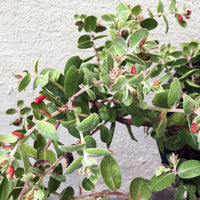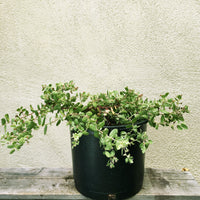

Arctostaphylos cruzensis
Arroyo de la Cruz Manzanita
An evergreen shrub that grows up to three feet high and five feet wide. White and pink flower clusters bloom in the winter and spring.
It is best to prune in the time when they are flowering to early summer. Each flower cluster terminates the growth of a shoot causing an irregular twiggy branching habit. It is not recommended to prune manzanitas during cool, wet winter months, this encourages fungal pathogens to spread. You can edge in late spring or early summer.
Plant with: Chamise (Adenostoma fasciculatum), Dwarf Coyote Brush (Baccharis pilularis), Blueblossom (Ceanothus thyrsiflorus), Coffeeberry (Frangula californica), Toyon (Heteromeles arbutifolia), Douglas Iris (Iris douglasiana), Twinberry Honeysuckle (Lonicera involucrata), Sticky Monkeyflower (Mimulus aurantiacus), Monterey Pine (Pinus radiata), Black Sage (Salvia mellifera), and Lupines (Lupinus species)
- Plant in full sun to part shade
- Best in sandy soils but tolerates clay
- Water one to two times per summer once established
- Drought tolerant
- Deer resistant
- Hardy up to 30 degrees
- Attracts hummingbirds, birds, bees, and butterflies
- California Native
This content type will accept rich text to help with adding styles and links to additional pages or content. Use this to add supplementary information to help your buyers.
You can use product metafields to assign content to this tab that is unique to an individual product. Use tabs to highlight unique features, sizing information, or other sales information.
Arroyo de la Cruz Manzanita
An evergreen shrub that grows up to three feet high and five feet wide. White and pink flower clusters bloom in the winter and spring.
It is best to prune in the time when they are flowering to early summer. Each flower cluster terminates the growth of a shoot causing an irregular twiggy branching habit. It is not recommended to prune manzanitas during cool, wet winter months, this encourages fungal pathogens to spread. You can edge in late spring or early summer.
Plant with: Chamise (Adenostoma fasciculatum), Dwarf Coyote Brush (Baccharis pilularis), Blueblossom (Ceanothus thyrsiflorus), Coffeeberry (Frangula californica), Toyon (Heteromeles arbutifolia), Douglas Iris (Iris douglasiana), Twinberry Honeysuckle (Lonicera involucrata), Sticky Monkeyflower (Mimulus aurantiacus), Monterey Pine (Pinus radiata), Black Sage (Salvia mellifera), and Lupines (Lupinus species)
- Plant in full sun to part shade
- Best in sandy soils but tolerates clay
- Water one to two times per summer once established
- Drought tolerant
- Deer resistant
- Hardy up to 30 degrees
- Attracts hummingbirds, birds, bees, and butterflies
- California Native


